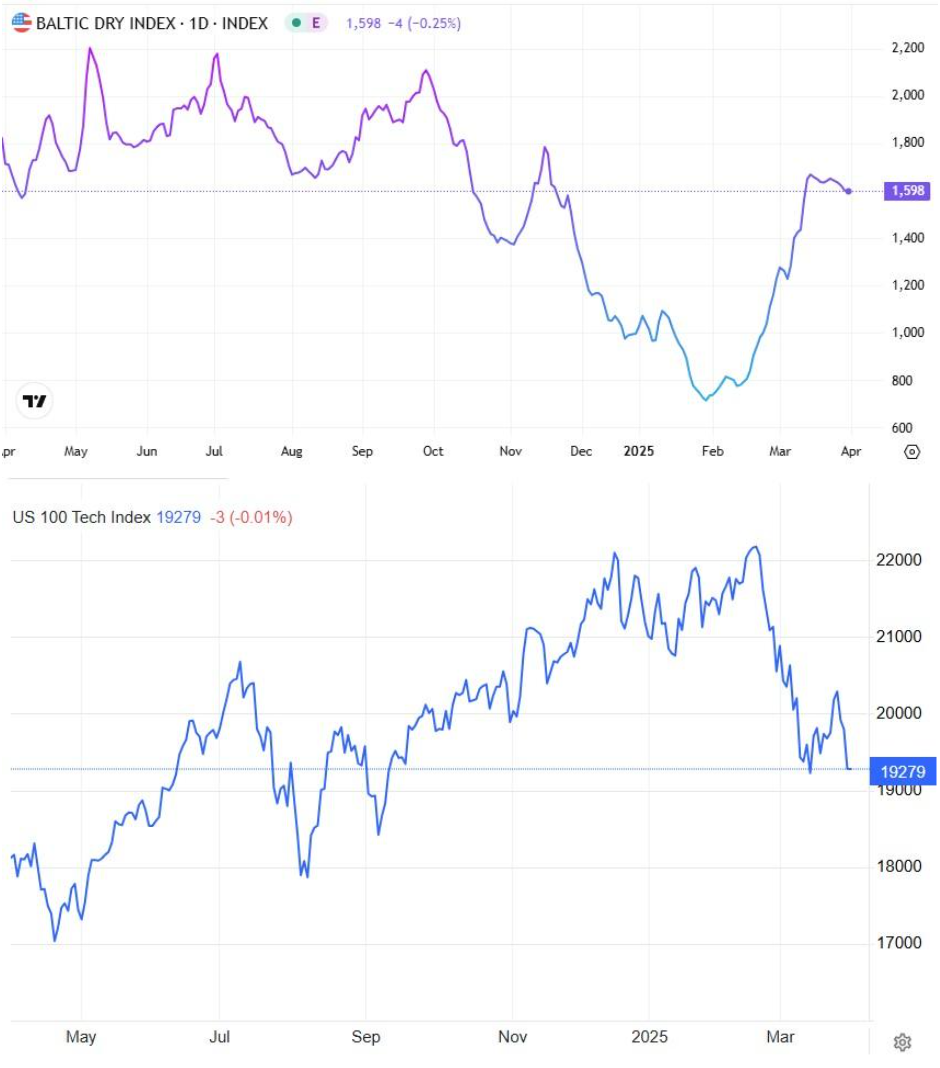As the first quarter of the year has come to a close, the shifts on the geopolitical and economic chessboard have produced mixed and complex sentiments and conclusions. Based on the performance of most investment instruments, global indices, and the reactions of global leaders and analysts, one thing is clear: the system is undergoing a reset, and the winner will be the most strategic and patient participant. Major transformations happen through careful planning, and from what we observe so far, some are moving according to a strategy, while others are only now starting to realize it—reacting in a more erratic manner.
One notable discrepancy lies in the performance of US indices compared to European indices, with a difference close to 20% year-to-date (+10% for Europe vs. -10% for the US). However, in March, the picture shifted: European indices posted modest gains of around 0.6%, while US indices saw losses ranging between 4.5% and 7%—meaning most of the US losses for Q1 occurred in March. Coincidence?
It’s also worth noting that within US indices, especially in March, many large-cap companies performed quite differently from the broader index trends. This divergence is partly due to significant inflows of investment capital into US equities—a trend we’ve noted previously. An additional factor is the exchange rate: the USD has hovered around 1.08 against the euro since the start of the year, potentially making US company valuations, particularly in the tech sector, more attractive to euro-denominated investors. These stocks are now trading at considerably lower P/E ratios (a pattern seen across all US indices), offering an extra discount of around 6% from the dollar’s depreciation.
The only consideration here is whether some investors still believe Trump lacks strategic political acumen or refuse to invest in the US due to his presence. If so, the factors above become irrelevant for them—though I believe a significant portion of investors still think this way.
We must also address the tariffs policy, which has become a central theme in generating the current sense of “insecurity,” high volatility across all asset classes, and a barrage of verbal interventions (what I would call "verbal QE"). Yet paradoxically, this has also led to a shift in stance from some previous Trump critics—such as Fed Chair Powell, who has adopted a notably dovish tone. Analysts are now expecting 3-4 rate cuts, while markets are pricing in two to three at most.
Yesterday, a statement from Fitch aligned with our thinking on tariffs, challenging the narrative that tariffs only negatively affect consumers while overlooking their impact on
corporate sales. This perspective now appears to be evolving. Trump’s policy isn’t solely about tariffs—it also includes tax reductions, lower interest rates, and new investments within the US, all of which could boost disposable income, drive domestic sales (especially in sectors like US-made cars, which he’s pushing to make more affordable for American buyers), and create jobs.
Take Hyundai’s example: the company plans to produce 300,000 cars for the US market without tariffs, targeting 500,000 units over time—already generating 140,000 jobs, with more expected as production scales up. Of course, it’s not easy for a multinational to invest that quickly just to avoid tariffs, but strategic acquisitions or partnerships with existing players offer a viable path—and there are plenty of opportunities.
Within all this supposed negativity, let’s not forget the promising outlook for many tech companies, which are now trading at far lower P/E ratios than just a few months ago—despite having once been market darlings. It seems many have forgotten the key theme of this year’s Davos meeting.
And let’s not overlook the Ukrainian issue—something I’ve highlighted in multiple previous pieces. I believe it is possibly the most important catalyst for the structural changes ahead. Refer to our earlier article where we mentioned Russia’s frozen assets due to European sanctions, along with the halted trading of Russian ADRs in the London market. These facts support Russia’s push for peace with Ukraine and the lifting of sanctions. Remember, we’re talking about frozen assets exceeding $800 billion.
Don’t rush to conclusions just yet—we’ll later tally the total value that might be affected across all these fronts.
We’re also following the $1 trillion reduction target set by DOGE, which could potentially be achieved by the end of May—coinciding with the end of Elon Musk’s term as special government advisor, a position limited to 130 days.
On April 2nd, new tariffs will come into effect in various countries, with rates ranging from the previously announced 25% to 15%-25% as per the latest updates while writing this.
As Trump’s administration marks its first 100 days at the end of April, we’ll see the initial assessment of its performance—while several major companies will also report earnings during the month.
Let’s now look at the numbers and their potential impact on markets, corporate balance sheets, and national GDPs:
- Tariffs affect global trade flows worth approximately $2.2 trillion annually
- US private debt at current interest rates costs Americans $1.3 trillion per year
- US public debt interest payments amount to $1.5 trillion annually
- The lifting of Ukraine-related sanctions could unlock $800 billion
- A resolution to the Ukraine conflict could yield global benefits exceeding $1 trillion annually, through reduced energy costs and increased trade. Rebuilding efforts are expected to last 7–10 years
- As for technology’s contribution to GDP, I won’t provide a number, but let’s consider this exercise: This week marks 25 years since the 2000 tech bubble, when the Nasdaq was at 7,000 points. Today it trades near 19,500. How much technology did each of us use in 2000—and how much more do we use now, both personally and in producing, delivering, and consuming goods and services?
Since advisors are expected to anticipate trends and shape the big picture, I found it important in this article to emphasize the positive strategic significance of the current developments—not the negative. As you've already deduced from the numbers above, the opportunities are significant. So, let’s not be swayed by false crossroads that may lead us down the wrong path—only to realize it when it’s too late.
I won’t end with Buffett’s famous motto, “Be greedy when others are fearful”, because in the context of today’s dynamics, no one wins in fear. Everyone is playing for a piece of a multi-trillion-dollar pie.
I believe our shipping magnates already understand this—which explains the trend we’re seeing in their order books. And one major rule of investing holds true: Follow the smart money.
To that, I’d add: Follow the smart advisor.
Wishing everyone a productive and profitable month ahead.

by Kotsiakis George









